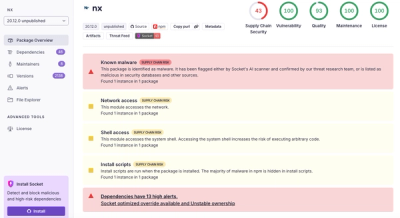
Security News
/Research
Wallet-Draining npm Package Impersonates Nodemailer to Hijack Crypto Transactions
Malicious npm package impersonates Nodemailer and drains wallets by hijacking crypto transactions across multiple blockchains.
@luudjanssen/next-locale-router
Advanced tools
Next.js v10 introduced [internationalized routing](https://nextjs.org/docs/advanced-features/i18n-routing) support. However, it's limited:
Next.js v10 introduced internationalized routing support. However, it's limited:
defaultLocale for subpaths, meaning always one locale will be available on / instead of /${locale}. next.js#18419nl-BE locale will be available under /nl-BE, it can't be changed to /nl for example. next.js#17078 (comment)It also contains a couple of bugs where the locale of domain X (/nl-BE) is also available under domain Y. So accessing domain-y.com/nl-BE works, even though nl-BE is not part of domain Y's configuration.
This package solves these problems by exposing Express middleware to route these use cases in the desired way.
Note: This package uses hacks that change Next.js internals to make this work. It's pretty well tested, but it's important to note that we only support Next.js version 10.2.0. If you use any other version, we can't guarentee routing will work.
This package requires you create a custom server.js file for your Next.js project and create a custom i18n.config.js file in the root of your project.
The configuration for the router is a superset of the Next.js i18n config. Create the i18n.config.js file in the root of your project and follow this syntax:
const dutchDomain = {
hostname: "nextjs.dutch",
defaultLocale: "nl",
subpaths: [
{
locale: "nl",
path: "/",
},
],
}
const belgianDomain = {
hostname: "nextjs.belgian",
defaultLocale: "nl-BE",
subpaths: [
{
locale: "nl-BE",
path: "/nl/",
},
{
locale: "fr",
path: "/fr/",
},
],
}
const domains = [dutchDomain, belgianDomain]
const defaultLocale = "nl"
module.exports = {
domains,
defaultLocale,
}
Since this configuration file is a superset of the Next.js i18n config we can create the Next.js config for you. This will result in the following next.config.js file:
const { withLocaleRouter } = require("@incentro/next-locale-router")
module.exports = withLocaleRouter()({
// Next.js config
})
Or, if you're using next-compose-plugins:
const withPlugins = require("next-compose-plugins")
const { withLocaleRouter } = require("@incentro/next-locale-router")
module.exports = withPlugins([withLocaleRouter()], {
// Next.js config
})
Next to the config.domains and config.defaultLocale options (which are required), you have the following options:
config.ignoreA function that allows you to force certain routes to be ignored by the locale router. It receives a parsed url as its parameter and should return a boolean:
const ignore = (url) => {
return url.pathname === "favicon.ico"
}
module.exports = {
domains,
defaultLocale,
ignore: (url) => ignore,
}
A common use case for this ignore parameter is to ignore routes in the public. Currently, next-locale-router doesn't ignore items in the public directory, because we can't easily determine what is a pages route and what is a public route and we don't want to rewrite Next.js's internals. For most public routes, this isn't a problem, because the routes are still accessible.
Take for example the favicon (favicon.ico). When a user is accessing the /favicon.ico route, but should be on the Dutch locale at /nl/, the request will be redirected to /nl/favico.ico and the image will still successfully be resolved.
The problem here is that our server will be handing out a lot of redirects and the client needs to do unnecessary redirects. You can add known public routes to the config.ignore option to prevent these redirects.
Create a server.js file in the root of the project, as per the Next.js standard. This example is an adapation of the custom-server-express Next.js template:
const next = require("next")
const express = require("express")
const { config, createLocaleMiddleware } = require("@incentro/next-locale-router")
const dev = process.env.NODE_ENV !== "production"
const app = next({ dev })
const handle = app.getRequestHandler()
const localeMiddleware = createLocaleMiddleware(config, app)
app.prepare().then(() => {
const server = express()
// Trust proxy is required if you're running behind a reverse proxy
// This is because we need to know the original hostname before the request was proxied.
server.set("trust proxy", true)
server.use(localeMiddleware)
server.all("*", (request, response) => handle(request, response))
server.listen(3000, (err) => {
if (err) throw err
console.log("> Ready on http://localhost:3000")
})
})
next-i18nextThe scopes of next-locale-router and next-i18next don't really overlap. next-locale-router handles routing and next-i18next receives the locale from Next.js and simply gets the translations. The only part where they overlap is in the configuration. next-i18next and next-locale-router share most of their config. Therefore we created a plugin to generate part of the next-i18next configuration for you:
next-i18next.config.js
const { configToNextI18NextConfig } = require("@luudjanssen/next-locale-router/next-i18next")
const config = require("./i18n.config")\
module.exports = {
i18n: configToNextI18NextConfig(config),
// ... Other next-i18next specific configuration
}
next-translateThe scopes of next-locale-router and next-translate don't really overlap. next-locale-router handles routing and next-translate receives the locale from Next.js and simply gets the translations. The only part where they overlap is in the configuration. next-translate and next-locale-router share most of their config. Therefore we created a plugin to generate part of the next-translate configuration for you:
i18n.js
const { configToNextTranslateConfig } = require("@luudjanssen/next-locale-router/next-translate")
const config = require("./i18n.config")
const path = require("path")
module.exports = {
...configToNextTranslateConfig(config),
// ... Other next-translate specific configuration
}
<Link> componentOn the client side we also need to rewrite the URL's. We do this by exposing a custom <Link> component, just like Next.js's <Link> component. It supports the exact same props as next/link, so you can just update your imports:
- import Link from "next/link"
+ import Link from "@incentro/next-locale-router/link"
Just like the custom <Link> component, we also need to update our URL's when using the client side router directly. We do this by wrapping next/router. The only thing you need to do is to update your next/router imports:
- import SingletonRouter from "next/router"
+ import SingletonRouter from "@incentro/next-locale-router/router"
useRouter hook- import { useRouter } from "next/router"
+ import { useRouter } from "@incentro/next-locale-router/router"
getServerSideProps and getStaticProps redirectsWhen redirecting with getServerSideProps or getStaticProps it's important to redirect to the right destination for the locale to prevent double redirects or even worse, a redirect loop. When creating redirects in getServerSideProps or getStaticProps you can use the addLocaleToRedirect method exported by this package.
import { addLocaleToRedirect } from "@incentro/next-locale-router/props"
export const getServerSideProps: GetServerSideProps = ({ locale }) => {
// This method rewrites the /about route to the right route for the given locale, e.g. `/nl/about`
const redirect = addLocaleToRedirect(
{
destination: "/about",
permanent: true,
},
locale,
)
return { redirect }
}
This project also exposes a utility method for stripping the locale from a path. This can be helpful to test for certain routes in your code. For example when checking the url of the getServerSideProps or getStaticProps context you'll see it includes the locale:
import { GetServerSideProps } from "next"
const getServerSideProps: GetServerSideProps = ({ resolvedUrl }) => {
console.log(resolvedUrl) // This would log "/nl/about" for the "pages/about.tsx" page
}
We can use the removeLocaleFromPath method from @incentro/next-locale-router/props to remove the /nl prefix:
import { GetServerSideProps } from "next"
import { removeLocaleFromPath } from "@incentro/next-locale-router/props"
const getServerSideProps: GetServerSideProps = ({ resolvedUrl }) => {
const urlWithoutLocale = removeLocaleFromPath(resolvedUrl)
console.log(urlWithoutLocale) // This would log "/about" for the "pages/about.tsx" page
}
If you want some additional debugging output in your console, set the NEXT_PUBLIC_LOCALE_ROUTER_DEBUG=true environment variable before starting the node process.
The middleware method receives the request and has to decide on one of the following strategies:
server.js example, it should be handled by Next.js, not by the middleware.This project consists of a strategy investigator and a strategy handler. The investigator determines what strategy is necessary and the handler actually executes the strategy. You can find them under src/strategy/strategy-investigator.class.ts and src/strategy/strategy-handler.class.ts respectively.
The strategy investigator follows the following steps to determine the strategy:
_next for example)?
config.ignore option?
/nl-BE/ to /nl/.
Accept-Language header, as well checking for the NEXT_LOCALE cookie set by Next.js. Otherwise it falls back to the defaultLanguage for the given domain.<Link> componentBesides having the server redirect URL's we also need to control client side routing. We do this by wrapping Next.js's <Link> component.
src/client/link/link.tsx → We use Next.js own <Link> component, but provide our own <LinkLocaleRewriter> as its child and we make sure we pass the href prop.
Next.js's <Link> component sets a couple of properties on its child, like the href prop and an onClick handler.
We wrap the onClick handler to make sure we can execute some code whenever a user click a <Link>.
src/client/link/util/wrap-click-handler-with-rewrite.ts → Whenever the user clicks on a <Link> we subscribe to Next.js router's beforeHistoryChange event which Next.js will fire.
When this event fires we trigger our own window.history.pushState instead of the one that Next.js would execute. This simply sets the browser's URL to the value we want.
How do we prevent Next.js from changing the URL? Well, here is where things get hacky. Check src/client/link/util/disable-history-push-state-for-one-tick.ts. This method overwrites the browser's window.history.pushState for one Javascript "tick". Because the beforeHistoryChange method is executed just before Next.js does its own history pushing, we point Next.js to an empty method. We use setTimeout to ensure we reinstate window.history.pushState in the next Javascript "tick".
I know, it's pretty hacky, but it's the only way I could update te client URL's without rewriting Next.js's <Link> component or showing a URL change to the user.
The wrapper of next/router works about the same as the <Link> component. We temporarily disable window.history.pushState for Next.js's own router and execute the state update ourselves. The only difference is that in this case we wrap the router.push and router.replace methods using a proxy. You can find the code for this at src/client/router/util/wrap-router-with-rewrites.ts.
<Link> component that supports the configuration.next/routergetServerSideProps() and getStaticProps()public directory?FAQs
Next.js v10 introduced [internationalized routing](https://nextjs.org/docs/advanced-features/i18n-routing) support. However, it's limited:
The npm package @luudjanssen/next-locale-router receives a total of 4 weekly downloads. As such, @luudjanssen/next-locale-router popularity was classified as not popular.
We found that @luudjanssen/next-locale-router demonstrated a not healthy version release cadence and project activity because the last version was released a year ago. It has 1 open source maintainer collaborating on the project.
Did you know?

Socket for GitHub automatically highlights issues in each pull request and monitors the health of all your open source dependencies. Discover the contents of your packages and block harmful activity before you install or update your dependencies.

Security News
/Research
Malicious npm package impersonates Nodemailer and drains wallets by hijacking crypto transactions across multiple blockchains.

Security News
This episode explores the hard problem of reachability analysis, from static analysis limits to handling dynamic languages and massive dependency trees.

Security News
/Research
Malicious Nx npm versions stole secrets and wallet info using AI CLI tools; Socket’s AI scanner detected the supply chain attack and flagged the malware.